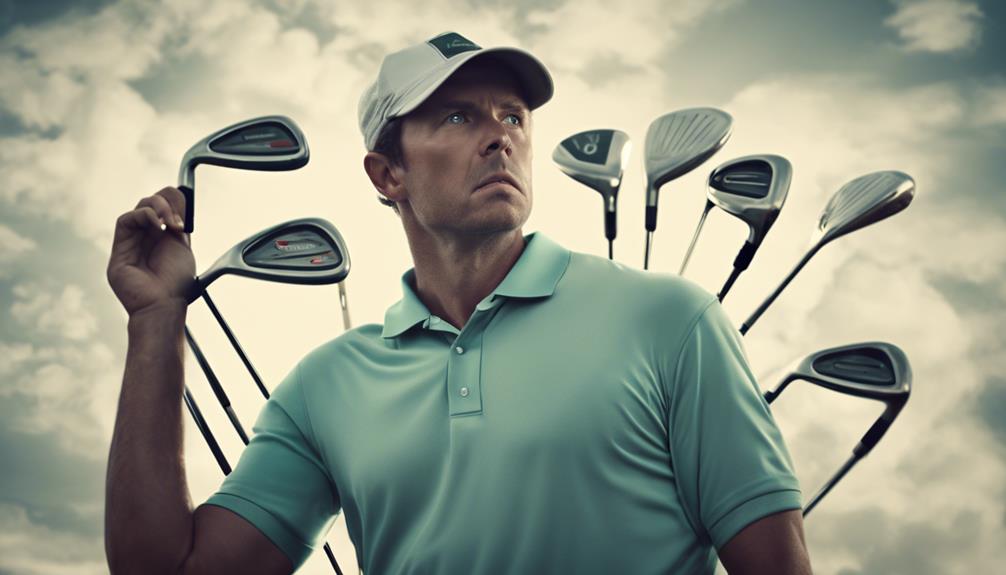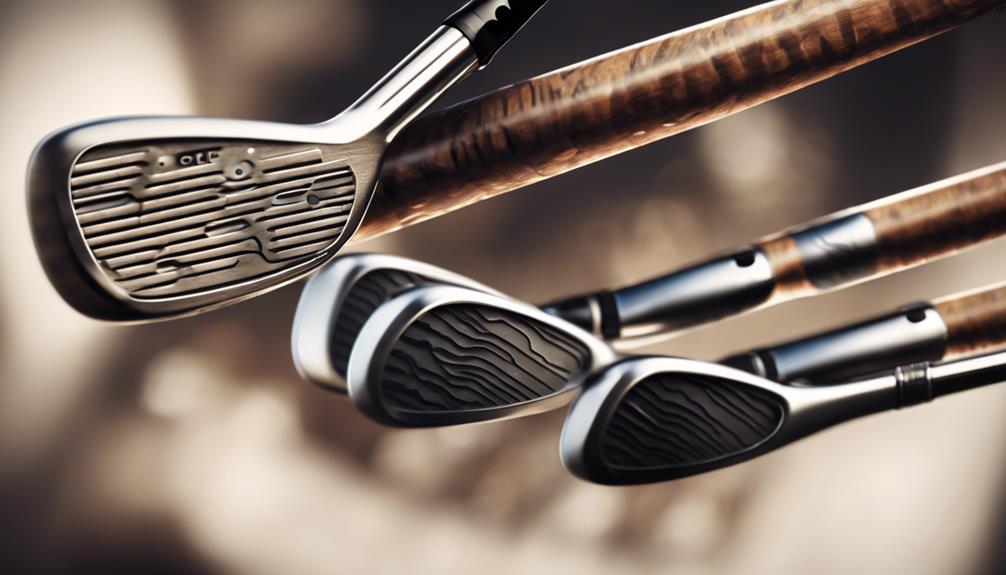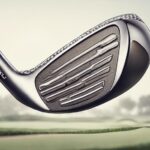- 7 Top Flite Golf Clubs XL for Improved Performance - September 28, 2024
- Top Flite Golf Clubs: Top 5 Reasons to Choose Them - September 28, 2024
- Top 3 Golf Club Fitters for a Perfect Swing - September 28, 2024
When you swing a golf club, the combination of the clubhead's design, loft angle, and face, along with the shaft's flexibility and your grip, work together to transfer energy to the ball, influencing its trajectory, distance, and spin. The clubhead's shape and size, as well as the loft angle, determine the ball's height and distance. The shaft's flexibility and your grip control the swing speed and direction. As you master the basics of golf clubs, you'll develop a clearer understanding of how each component contributes to your shot's success, and you'll be well on your way to revealing the full potential of your game.
Key Takeaways
- Clubhead design, loft angle, and club face affect ball trajectory and distance, with loft angle determining height and distance of ball travel.
- The right club selection is influenced by distance to green and shot type required, with understanding of specific club purpose aiding decision-making.
- Shaft flexibility and length affect swing speed and control, while grip design ensures control and comfort during swings.
- Hitting the sweet spot on the clubface maximizes energy transfer, and consistent contact leads to improved shot performance.
Understanding Golf Club Basics
You'll find that golf clubs, at their core, comprise three essential components: the clubhead, shaft, and grip, each playing a distinct role in determining the performance and control of your swing.
The clubhead is the most important component, as it's responsible for striking the ball. Its design, particularly the club face and loft angle, greatly influences the ball's trajectory and distance. The loft angle, or the angle of the club face, is key in determining the height and distance the ball will travel when struck. Understanding the loft of a club is essential, as it affects the overall performance of your swing.
Club heads come in various shapes and sizes, each suited for specific swing styles and ball trajectories. By understanding the intricacies of the clubhead, you'll be better equipped to make informed decisions when selecting the right club for your game.
Types of Golf Clubs Explained
Five primary categories of golf clubs exist, each engineered to excel in specific shot distances and purposes. As you explore your set of golf clubs, you'll find woods, irons, hybrids, wedges, and putters, each designed to tackle unique challenges on the course.
Woods, like drivers, boast larger heads and lower lofts (7-12 degrees) for long-distance shots, typically used for teeing off. In contrast, your set of irons, numbered 2-9, feature smaller heads and varying lofts, making them suitable for approach shots, usually from 120-190 yards.
Hybrids blend characteristics of woods and irons, providing a more forgiving option for longer shots, often replacing long irons in many golfers' bags. Wedges, with lofts ranging from 48 to 64 degrees, are specialized for short, high shots around the green and for sand bunker play.
Understanding the distinct roles of each club type will help you make informed decisions on the course, ultimately improving your overall game.
Club Selection and Psychology

As you step onto the course, you're faced with a vital decision: which club to choose for the shot ahead.
Your club selection strategy depends on various factors, including the distance to the green, the type of shot required, and your personal strengths and weaknesses.
Club Selection Strategy
With a well-rounded set of clubs at your disposal, developing a strategic club selection approach is critical for optimizing your performance on the course.
You need to understand the specific purpose of each club and how to choose the right one for the shot you're facing. This involves taking into account factors like golf club number, loft angle, and the distance you need to strike the golf ball.
For instance, if you're 150 yards from the green, you'll likely need a 7-iron or 8-iron, depending on the trajectory you want to achieve. By understanding the capabilities of each club, you can make informed decisions about which one to use, even in high-pressure situations like the tee and green.
It's crucial to reflect on your individual needs, preferences, and skill level when selecting clubs to guarantee you have the right tools for your game.
Golfer's Mental Approach
When you stand over the ball, your mental approach to club selection can make all the difference between a successful shot and a disastrous one. This approach influences your confidence in the chosen club and your ability to execute the shot. You need to trust your decision-making process, knowing that each club is designed for a specific purpose and distance.
Here are three key scenarios where your mental approach is essential:
- Tee shot confidence: You're more likely to hit a longer distance with your driver if you believe in your club choice and trust your swing.
- Approach shot precision: Selecting the right iron or wedge can make all the difference in getting the golf ball close to the pin.
Golf Club Mechanics and Dynamics
You manipulate the golf club's mechanical components, including the clubhead, shaft, and grip, to generate the precise swing dynamics that dictate the ball's flight.
The clubhead, with its carefully designed loft, plays an important role in determining the ball's trajectory and distance. A lower loft will produce a longer shot, while a higher loft will result in a shorter, higher trajectory.
The shaft, connecting the clubhead to the grip, influences swing speed, control, and overall feel. It's vital to find the right shaft flexibility and length to match your swing style.
As you swing, the grip provides the necessary control and comfort. A well-designed grip helps you maintain a consistent swing plane and prevents slipping or twisting.
The 'sweet spot' on the clubface is where maximum energy transfer occurs, resulting in more effective shots. When you strike the ball at the sweet spot, you'll experience a more solid, consistent feel.
Technology and Historical Context

As golfers master the mechanical components of their clubs, they can now explore how technological innovations have reshaped the game, elevating performance and redefining the limits of human achievement.
You've likely witnessed the transformation from wooden heads to modern designs featuring titanium and carbon fiber, which have greatly enhanced performance and durability.
Here are three key advancements that have revolutionized the game:
- Adjustable clubheads: Allowing you to customize loft and lie angles for a perfect fit and optimized performance.
- Aerodynamic designs: Reducing drag during the swing, resulting in increased swing speed and distance, making the ball travel farther on the golf course.
These innovations haven't only improved your game but have also influenced competitive success, as seen in historical performance benchmarks like Tiger Woods' remarkable 272 score in the 2000 U.S. Open.
As you take to the course, remember that the technology in your hands has the power to transform your game.
Applying Golf Club Knowledge
Mastering the intricacies of golf club selection and application is essential to releasing improved performance and enjoyment on the course.
To do so, you need to know how to harness the unique characteristics of each club type, from woods to putters. By understanding the design elements that influence shot trajectory and distance, such as loft and clubhead design, you can make informed decisions during play.
Practicing with different clubs and tracking your average distances will help you develop a solid grasp of shot selection, leading to better overall game performance.
It's also vital to familiarize yourself with the concept of 'letting the club do the work,' trusting the club's design to produce the desired outcome rather than relying on brute force.
As you gain experience using various clubs in real-world situations, you'll develop a deeper understanding and confidence in your club selection, ultimately enhancing your enjoyment of the game.
Frequently Asked Questions
How Do I Know Which Golf Club to Use?
When choosing a golf club, you'll want to evaluate club selection tips, such as distance, loft, and your personal average with each club. As a beginner golfer, follow advice to assess your swing and trust the club's design for better performance.
What Do the Golf Club Numbers Mean?
Imagine a ladder, where each rung represents a golf club number, ascending in loft angle; you're climbing to master shot control, as lower numbers (3-iron) yield longer, lower shots, and higher numbers (9-iron) produce shorter, higher ones, illustrating club numbering significance and iron types explained.
When to Use 7 Iron?
When you're 140-160 yards from the green, you'll want to use your 7 iron, as it's ideal for this distance, allowing you to employ precise techniques and achieve a high, controlled trajectory for a pinpoint approach.
What Does It Mean to Let the Club Do the Work?
When you let the club do the work, you trust its mechanics to generate power, focusing on a smooth, efficient swing that harnesses clubhead speed and weight, resulting in ideal swing efficiency and consistent shots.
Conclusion
You've now grasped the intricacies of golf clubs, from their design and mechanics to the psychology of selection.
As you step onto the course, remember that a staggering 60% of golfers use the wrong club, resulting in lost strokes and frustration.
Armed with your newfound knowledge, you'll be among the 40% who make informed decisions, shaving precious strokes off your score.
With practice and patience, you'll be well on your way to becoming a golfing pro.




